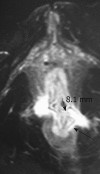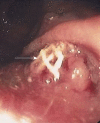Management of recto-vaginal fistulas after prosthetic reinforcement treatment for pelvic organ prolapse
- PMID: 20572304
- PMCID: PMC2890941
- DOI: 10.3748/wjg.v16.i24.3011
Management of recto-vaginal fistulas after prosthetic reinforcement treatment for pelvic organ prolapse
Abstract
Aim: To communicate our findings on successful treatment of recto-vaginal fistulas (RVFs) after prosthetic reinforcement surgery of pelvic organ prolapse (POP).
Methods: A retrospective single center study between 1998 and 2008 was performed. A total of 80 patients with RVF were identified, of which five patients (6%), with a mean age of 65 years (range: 52-73), had undergone previous surgery for POP with prosthetic reinforcement.
Results: All patients complained about ongoing vaginal infections and febrile episodes. These symptoms were reported after a mean period of 18 mo after POP repair. As a first intervention, three patients underwent ablation of the prosthetic material (PM). As a second intervention, open proctectomy with a primary anastomosis, an omental patch, and a protective ileostomy were performed in two patients. One patient required a terminal colostomy due to complete destruction of the anal sphincters. In two other patients, ablation of the PM and proctectomy was performed as a one-step procedure. The postoperative course in all patients was uneventful, with a mean length of hospitalization of 20 d (range: 15-30). Closure of the ileostomy was achieved in all four patients within four months. After a mean period of 35 mo (range: 4-60) of follow-up, no recurrence was observed with normal continence in four patients.
Conclusion: In our experience, the definitive treatment of high RVFs after PM repair for POP necessitates ablation of the PM, proctectomy with a primary colo-rectal anastomosis, an omental patch interposition, and a temporary ileostomy.
Figures


References
-
- Beer M, Kuhn A. Surgical techniques for vault prolapse: a review of the literature. Eur J Obstet Gynecol Reprod Biol. 2005;119:144–155. - PubMed
-
- Olsen AL, Smith VJ, Bergstrom JO, Colling JC, Clark AL. Epidemiology of surgically managed pelvic organ prolapse and urinary incontinence. Obstet Gynecol. 1997;89:501–506. - PubMed
-
- Savary D, Fatton B, Velemir L, Amblard J, Jacquetin B. [What about transvaginal mesh repair of pelvic organ prolapse? Review of the literature since the HAS (French Health Authorities) report] J Gynecol Obstet Biol Reprod (Paris) 2009;38:11–41. - PubMed
-
- Maher C, Baessler K, Glazener CM, Adams EJ, Hagen S. Surgical management of pelvic organ prolapse in women. Cochrane Database Syst Rev. 2007:CD004014. - PubMed
-
- Feiner B, Jelovsek JE, Maher C. Efficacy and safety of transvaginal mesh kits in the treatment of prolapse of the vaginal apex: a systematic review. BJOG. 2009;116:15–24. - PubMed
Publication types
MeSH terms
LinkOut - more resources
Full Text Sources
Medical
Research Materials

